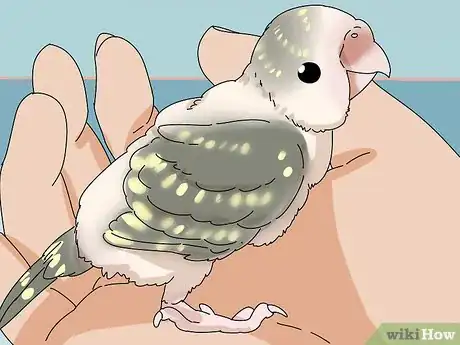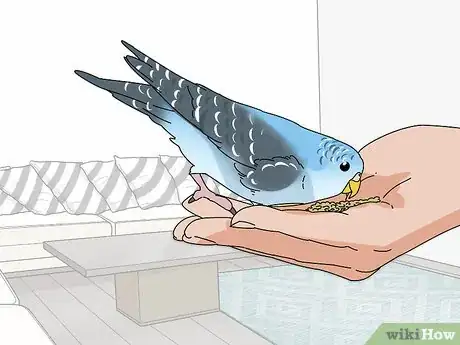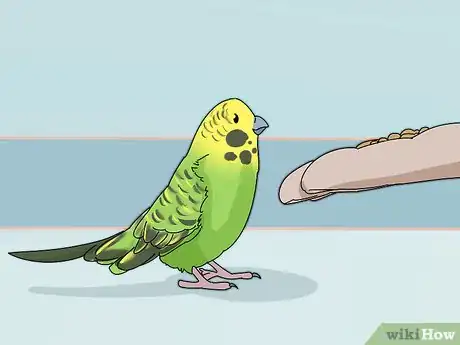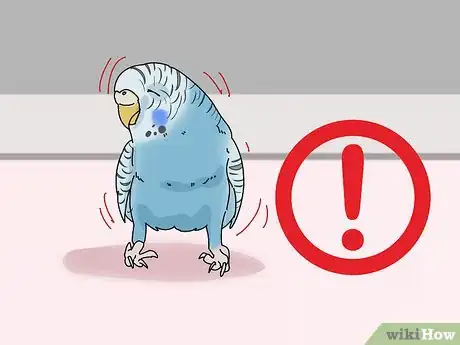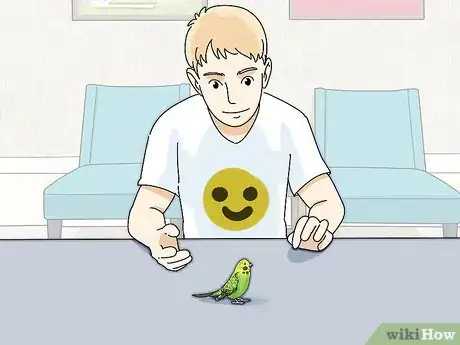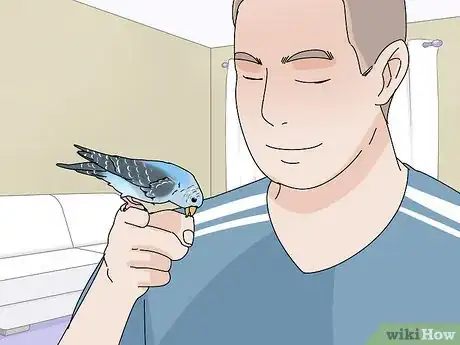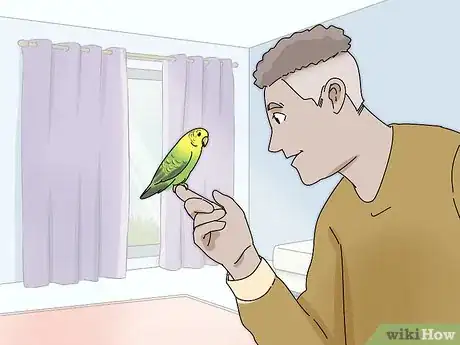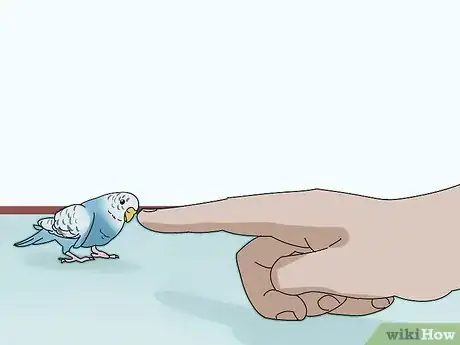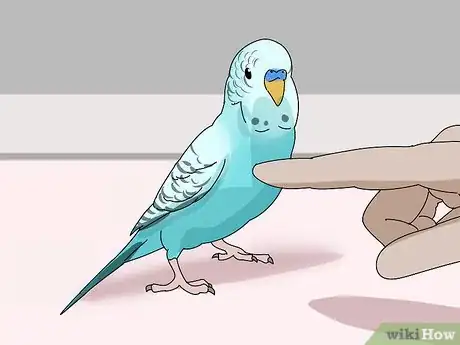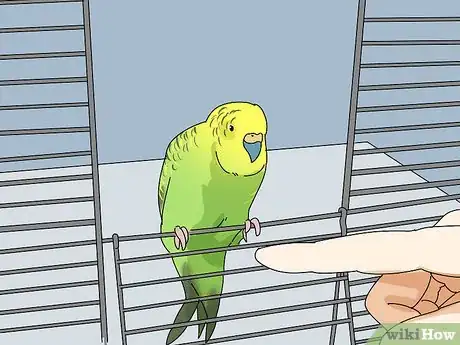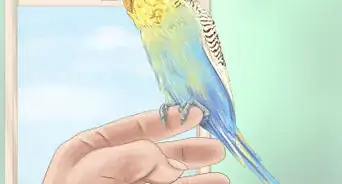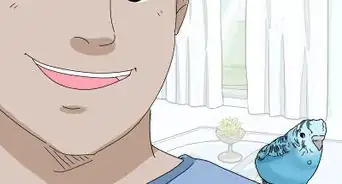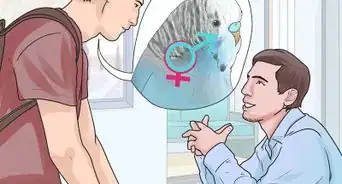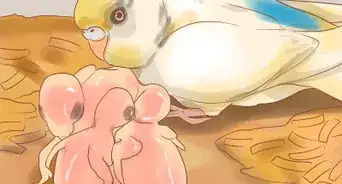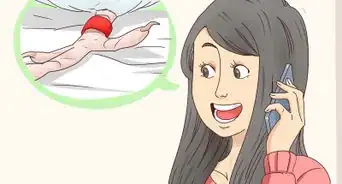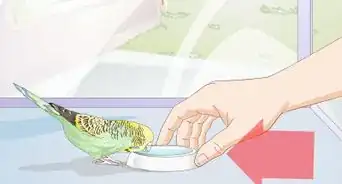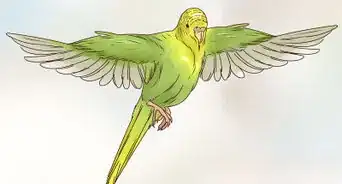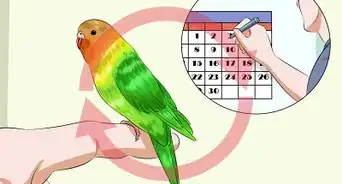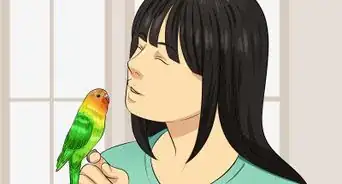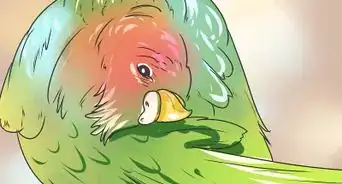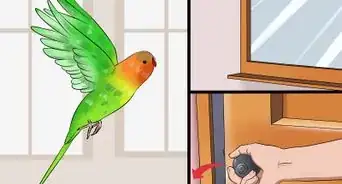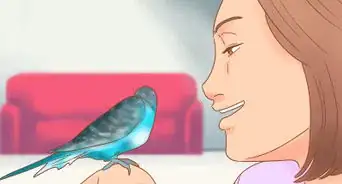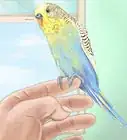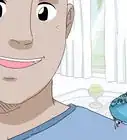This article was co-authored by Pippa Elliott, MRCVS. Dr. Elliott, BVMS, MRCVS is a veterinarian with over 30 years of experience in veterinary surgery and companion animal practice. She graduated from the University of Glasgow in 1987 with a degree in veterinary medicine and surgery. She has worked at the same animal clinic in her hometown for over 20 years.
This article has been viewed 185,825 times.
When you adopt a parakeet or budgie as a pet, the last thing you want is for your new feathered friend to bite you. In fact, this behavior, once it begins, can become ingrained in the parakeet, and this can threaten your love for your pet. In order to stop your parakeet from biting you, follow these guidelines.
Steps
Bonding With Your Parakeet
-
1Adopt a parakeet from the youngest age possible. Parakeets are very sociable,[1] and if you become part of their flock, you will have a more loving friend. To do this, simply spend lots of time with your bird from a young age, and he or she will become accustomed to your hands. This will help prevent your parakeet from biting you in the first place.
-
2Feed the parakeet from your hand. If a parakeet associates your hand with something positive—like food—it will be less scared and therefore less likely to bite you. Not only can this help keep the bird from biting you, it will help them become friendlier in general.
- If the parakeet feels threatened by your hand, you may have trouble feeding it from your hand. In this case, try using a spoon at first and gradually choking up on the handle, then placing the spoon head in your fingers, then palm, etc. until you can discontinue using the spoon and encourage the bird to eat from your hand.
Advertisement -
3Reward the parakeet with treats and food. Feeding your parakeet from your hand is one way to develop a bond, but you can also use food and treats to reward the bird for good behavior. For example, if you successfully got the parakeet onto your hand or even out of the cage for the first time (see parts below) you can use treats or food to reward the bird for that behavior. When the bird understands the reward system, it will learn to do what you want it to do in exchange for the food or treat.
-
4Look for reasons why the bird is biting. Parakeets may bite out of fear or jealousy, because they are tired, due to unintended reinforcement of biting behavior, in anticipation of being placed back in the cage when they do not want to be, or to protect their territory.[2] You will be more successful at bonding with your parakeet and reducing biting behavior if you know why your bird bites. Armed with this information, you may tailor your approach to helping put a stop to biting more specifically.
Interacting Appropriately With Your Parakeet
-
1Move very slowly. If you move too fast you'll scare the bird. In general, you must move slowly around the bird if you want them to become tame enough to stop biting behavior. Do not place the cage in a high-traffic of your home, as too much commotion may be disturbing.
-
2Stay calm if the bird bites you. If you quickly remove your hand from the cage when your bird bites, he or she may be getting just the reaction they are hoping for and continue the behavior. The bird may also be entertained by your reaction and continue the behavior for this reason. Be sure to remain calm if the bird bites—its bites are unlikely to break the skin, and they will probably not hurt that much. In response to biting behavior, simply say no firmly and cover the cage. The isolation this produces is not something the bird likes, so you will be discouraging biting behavior. It also calms the bird.[3]
-
3Talk softly to your bird. The goal of proper interaction with your parakeet is essentially taming the bird. Talking softly around the bird helps it to feel calm around you, which can help with taming. Talking too loudly or shouting near the bird (not even necessarily to the bird) can scare it.[4]
Training Your Parakeet
-
1Train the parakeet to perch on your finger. Getting your parakeet to perch on your finger is part of hand-training. Finger-perching may take a while to achieve, but the patience should pay off in the end by developing a strong bond between you and your bird and minimizing biting behavior. Follow subsequent steps in this section to achieve finger-perching.[5]
- Be mindful of the bird's mood—he or she may not be interested in trying finger-perching just because you want him or her to. Keep this in mind as you begin to train the bird, and try to be aware of the bird's mood so you don't irritate or frustrate it.
-
2Put your finger on the parakeet's chest and push lightly. This does not hurt your bird, but it will make it lose its balance and coax it into putting its foot on your finger. It may not happen the first time, so if the bird flies away, try again the next day.[6]
- Practice these steps each day to get the bird comfortable perching on your hand. Doing so will help put an end to biting behavior.
-
3Finger-train your parakeet out-of-the-cage. Once your bird is comfortable perching on your finger, begin trying to bring it outside the cage on your finger. Use a vocal cue such as saying "up" in an enthusiastic voice. The bird may not want to venture too far outside the cage, but keep trying and you should be able to get him or her to go farther and farther each time. If they fly away, they will eventually go back to their cage, as that's where they feel safe.[7]
- Once your bird is finger trained out-of-the-cage, he or she will trust you a lot more, so biting should cease.
Expert Q&A
Did you know you can get expert answers for this article?
Unlock expert answers by supporting wikiHow
-
QuestionWhat happens if the bird is scared?
 Pippa Elliott, MRCVSDr. Elliott, BVMS, MRCVS is a veterinarian with over 30 years of experience in veterinary surgery and companion animal practice. She graduated from the University of Glasgow in 1987 with a degree in veterinary medicine and surgery. She has worked at the same animal clinic in her hometown for over 20 years.
Pippa Elliott, MRCVSDr. Elliott, BVMS, MRCVS is a veterinarian with over 30 years of experience in veterinary surgery and companion animal practice. She graduated from the University of Glasgow in 1987 with a degree in veterinary medicine and surgery. She has worked at the same animal clinic in her hometown for over 20 years.
Veterinarian Focus on building his confidence. Site the cage in a room where he can watch your comings and goings butt without feeling overwhelmed or threatened. Once his is happy watching activities, spend time sitting next to the cage, reading or watching TV. Then speak gently to him and offer treats through the bars of the cage. Slowly win his trust by letting him see there's nothing to be fearful of and that your presence means good things.
Focus on building his confidence. Site the cage in a room where he can watch your comings and goings butt without feeling overwhelmed or threatened. Once his is happy watching activities, spend time sitting next to the cage, reading or watching TV. Then speak gently to him and offer treats through the bars of the cage. Slowly win his trust by letting him see there's nothing to be fearful of and that your presence means good things. -
QuestionWhat if the bird was already trained to step up, but he bites if I try to hold him? When the previous owner tried, he was just fine.
 Pippa Elliott, MRCVSDr. Elliott, BVMS, MRCVS is a veterinarian with over 30 years of experience in veterinary surgery and companion animal practice. She graduated from the University of Glasgow in 1987 with a degree in veterinary medicine and surgery. She has worked at the same animal clinic in her hometown for over 20 years.
Pippa Elliott, MRCVSDr. Elliott, BVMS, MRCVS is a veterinarian with over 30 years of experience in veterinary surgery and companion animal practice. She graduated from the University of Glasgow in 1987 with a degree in veterinary medicine and surgery. She has worked at the same animal clinic in her hometown for over 20 years.
Veterinarian The bird associates his previous owner with safety, but hasn't fully learned to trust you yet. Take things in baby steps. First, win his confidence. Do this by talking softly to him and offering treats through the cage bars. Gradually, get him used to being hand fed, and then once he accepts your presence, he will be ready to step up.
The bird associates his previous owner with safety, but hasn't fully learned to trust you yet. Take things in baby steps. First, win his confidence. Do this by talking softly to him and offering treats through the cage bars. Gradually, get him used to being hand fed, and then once he accepts your presence, he will be ready to step up. -
QuestionI'm taming a male parakeet, but there are good days and bad days. Does it take time?
 Pippa Elliott, MRCVSDr. Elliott, BVMS, MRCVS is a veterinarian with over 30 years of experience in veterinary surgery and companion animal practice. She graduated from the University of Glasgow in 1987 with a degree in veterinary medicine and surgery. She has worked at the same animal clinic in her hometown for over 20 years.
Pippa Elliott, MRCVSDr. Elliott, BVMS, MRCVS is a veterinarian with over 30 years of experience in veterinary surgery and companion animal practice. She graduated from the University of Glasgow in 1987 with a degree in veterinary medicine and surgery. She has worked at the same animal clinic in her hometown for over 20 years.
Veterinarian
Warnings
- Keep a close eye. Birds can get lost, stepped on, or sat on if you don't pay attention to where they go.⧼thumbs_response⧽
- Keep birds away from children. They can mistakenly hurt birds by thinking of them as playful toys, and the birds may even bite or injure the child.⧼thumbs_response⧽
References
- ↑ http://pets.thenest.com/bonding-parakeet-9600.html
- ↑ http://www.petbudgie.com/biting/territorial/
- ↑ http://www.lisashea.com/petinfo/handtrain/biting.html
- ↑ http://budgieplace.com/taming.html
- ↑ http://www.lisashea.com/petinfo/articles/bird_hand.html
- ↑ http://www.lisashea.com/petinfo/articles/bird_hand.html
- ↑ http://www.lisashea.com/petinfo/handtrain/fingerout.html
About This Article
To stop a parakeet from biting, try feeding it from your hand so it will associate your hand with something positive instead of something to be scared of. Make sure that you move slowly and talk softly around your bird to avoid scaring it. Additionally, train your bird to perch on your finger by pushing lightly on its chest to coax it into putting its foot on your finger. Repeat the process at least once a day to build a bond with your bird and help put an end to its biting behavior. For more tips from our Veterinary reviewer, like how to find out why your parakeet is biting, read on!
